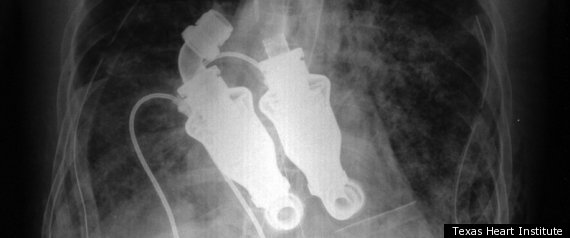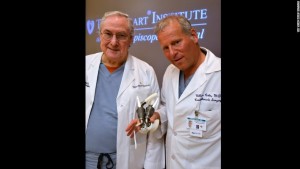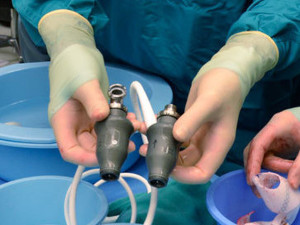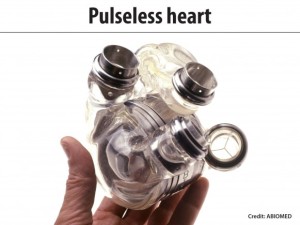A Well Thought Out Scream By James Riordan: Surviving Without A Pulse : The Continuous Flow Mechanical Heart

The human heart beats 60 to 100 times a minute, more than 86,000 times a day, 35 million times a year. A single beat pushes about 6 tablespoons of blood through the body. An organ that works that hard is bound to fail, says Dr. Billy Cohn, a heart surgeon at the Texas Heart Institute. And he’s right. Heart failure is the leading cause of death in men and women, killing more than 600,000 Americans every year.
For a lucky few, a heart transplant will add an average of 10 years to their lives. For others, technology that assists a failing heart — called “bridge-to-transplant” devices — will keep them alive as they wait for a donor heart. Unfortunately, more often than not, the new heart doesn’t arrive in time.
Dr. Cohn is a veteran surgeon, as well as an inventor and researcher who has spent a large portion of his life developing technologies to replace or repair the human heart. In 2004, Dr. Bud Frazier at the Texas Heart Institute Frazier asked Cohn to collaborate on a new research project. Cohn’s interest in heart surgery dates back to when he was a young boy reading articles about world-renowned heart surgeons Dr. Michael E. Debakey and Dr. Denton Cooley, who developed and played a role in the transplant of the first artificial heart in a human in 1969. Now the holder of some 70-odd U.S. patents, Cohn says his work with Frazier to build an artificial heart is the most ambitious project of his career.
The surgeons set out to combine two LVADs to replicate the functions of the heart’s right and left ventricles. Using two commercially available LVAD turbines, Frazier and Cohn combined the devices with plastics and other material used for implants: hernia mesh, Dacron cardiovascular patches and medical silicone. Everything met FDA standards, but Cohn describes the final product as “rather kludged together.”

The surgeons tested their invention by installing it in around 70 calves. They removed the heart of the animals, replaced it with the device, and by the next day, the calves are doing just fine with their usual routine – eating, sleeping, and moving. Only this time, without a heart pumping blood through their bodies. All of the cows produced a flat line on an EKG, which measures heart electrical activity, yet they stood, ate and walked around, paying seemingly no notice to a small technicality: They had no heartbeat.
In order for the FDA to approve the device for clinical trials, the calves needed to live for at least one month. Cohn and Frazier’s device trumped these standards, with many calves living healthily for full 90-day studies.
Cohn and Frazier were encouraged and worked to develop a long-term, artificial replacement for the failing human heart. Unlike existing short-term devices that emulate the beating organ, the new machine would propel blood through the body at a steady pace so that its recipients will have no heartbeat at all.
They felt confident enough to try their device on a human patient and chose Craig Lewis, a 55-year-old who was dying from amyloidosis, which causes a buildup of abnormal proteins. The proteins clog the organs so much that they stop working. In Lewis’ case, his heart became so damaged, doctors said he had about 12 hours left to live. Without immediate medical intervention Craig would have likely died within days because not even a pacemaker could help save his life. His wife, Linda, said they should try the artificial heart.
Cohn and Frazier removed Mr Lewis’ heart and then installed the device, replacing his heart with a “continuous flow” device that would allow blood to circulate his body without a pulse. Within a day, the patient was up, feeling well and speaking with physicians. Linda was astonished when she tried to listen to his pulse. “I listened and it was a hum, which was amazing, he didn’t have a pulse.”
The concept of a pulseless heart is difficult to fathom. Cohn often compares it to the development of the airplane propeller. “When people started to develop flying machines,” he said, “they first tried to emulate the way birds fly — by flapping the wings aggressively. It wasn’t until they decided, ‘We can’t do this the way Mother Nature did,’ and came up with the rapidly spinning propeller that the Wright Brothers were able to fly.”
Even though Craig Lewis now had a healthy heart, he still had amyloidosis. The disease began to attack Lewis’ liver and kidneys and he died a month later. He lived for more than a month with the pulseless heart and died in due to the underlying disease. His doctors say the pumps themselves worked flawlessly.
Lewis’s case proved what Frazier and Cohn had dreamed of for nearly half a century: Humans can indeed survive without a pulse.
Saddened by Lewis’ death Cohn at least felt encouraged that the device had performed flawlessly. He has devoted the last half century to developing technologies to fix or replace the human heart, the most notable of which is the newest generation of continuous flow Left Ventricular Assist Devices, known as LVADs. Modeled after an Archimedes Screw, a machine that raises water to fill irrigation ditches, the continuous flow LVAD is a pump that helps failing hearts push additional blood through the body with a rapidly spinning impeller.
Today, the continuous flow LVAD has been implanted in 20,000 people worldwide, including former Vice President Dick Cheney before he received a heart transplant nearly two years later. In some cases, the LVAD’s turbine has essentially taken over the pumping process entirely from the biological heart. In these instances, the implant recipient barely has any pulse at all.

Observing what happened in these patients led Frazier to one compelling question: If the LVAD can take over for a weakened heart, could it replace the organ entirely?
The doctors say the continuous-flow pump should last longer than other artificial hearts and cause fewer problems. That’s because each side has just one moving part: the constantly whirling rotor. But Cohn says they will still have to convince the world that you don’t need a pulse to live.
“We look at all the animals, insects, fish, reptiles and certainly all mammals, and see a pulsatile circulation,” he says. “And so all the early research and all the early efforts were directed at making pulsatile pumps.”
However, the only reason blood must be pumped rhythmically instead of continuously is the heart tissue itself. “The pulsatility of the flow is essential for the heart, because it can only get nourishment in between heartbeats,” Cohn says. “If you remove that from the system, none of the other organs seem to care much.”
Cohn describes the Syncardia, which has been transplanted in nearly 1,300 people to date as a “brilliant and elegant device,” but the device is for short-term use only and is cumbersome. Patients “have to carry around a compressor and have two air hoses going in and out of your chest.”
Frazier and Cohn see a pulseless device as the only compromise to develop an artificial heart that is both efficient and long-term.
Two years ago, Daniel Timms, a 35-year-old Australian biomedical engineer, made an Australian government funded trip to Houston, stumbling through the door of Cohn’s office at the Texas Heart Institute. Timms was wearing blue jeans and a T-shirt and carrying a heart device he had been working on for the past 10 years in his backpack.
Cohn was skeptical at first: “A lot of people come to our door with devices and prototypes, and they range from moderately interesting to laughably stupid. … My expectations were very low. He pulls this thing out and starts telling me about it, and I quickly realized this is the most sophisticated and elegant device I’ve ever seen.”
Made up of one moving part that rotates within a can-like exterior no bigger than a fist, the device has a large and small blade on opposing sides of the rotor. The small blade pushes blood through the heart’s right chamber, to the lungs, and the larger blade pumps out blood through the left chamber to the rest of the body.
What fascinated the two surgeons most was that the device operates by being suspended in a powerful magnetic field, which prevents the wear and tear common in technology designed for pumping blood. Two magnetic fields also control the blades’ oscillations, which each rotate an average of 2,000 times a minute depending on whether a person is standing, sitting up, exercising or coughing.
The excitement over the technology drew a $2.4 million donation from Houston furniture store owner, James Mackingvale, allowing Timms and a team of seven researchers from Australia, Germany, Japan and Brazil to relocate to Houston in January to collaborate with the Texas Heart Institute.
Timms’ group also brought a 3-D printer, which enables the medical staff to quickly make its own parts for the artificial heart. Within days, the doctors can print a new part that pumps the blood and then can evaluate its performance, a process that once took months.
They’re now working on a titanium version of the device as a prototype for a more durable technology. Once that device is developed, they will begin animal testing, measuring the results to determine whether the technology is ready to propose implanting into terminally ill human patients.
If all goes well, Cohn, Frazier and Timms would be able to submit the device for FDA approval within the next few years.
Frazier believes this artificial heart will save a lot of patients he loses today, particularly those who suffer from premature heart failure. “This is not something ready for prime-time yet,” he says, but for those suffering now “we hope to give them hope.”
___







No Comment